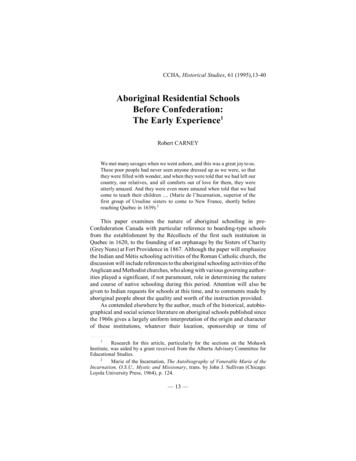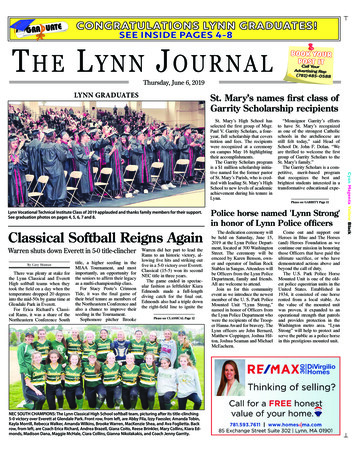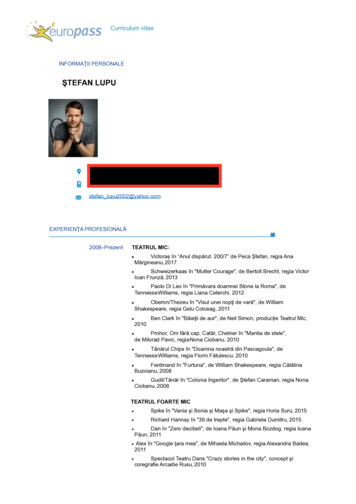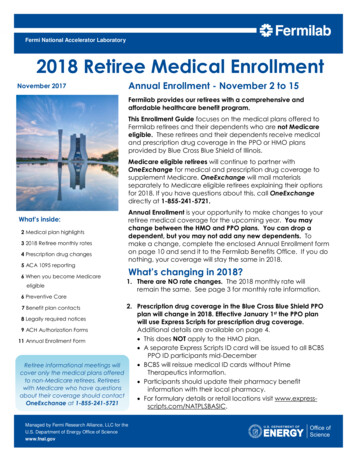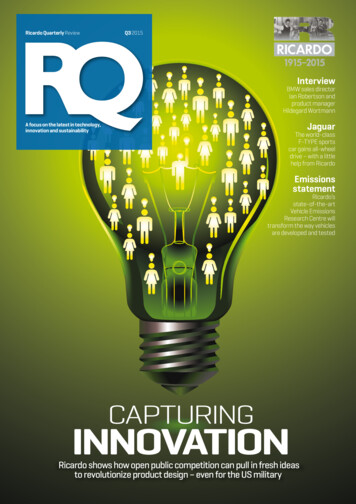
Transcription
RicardoQuarterly ReviewFeature headingQ3 2015InterviewBMW sales directorIan Robertson andproduct managerHildegard WortmannJaguarA focus on the latest in technology,innovation and sustainabilityThe world-classF-TYPE sportscar gains all-wheeldrive – with a littlehelp from rtVehicle EmissionsResearch Centre willtransform the way vehiclesare developed and testedCapturinginnovationRicardo shows how open public competition can pull in fresh ideasto revolutionize product design – even for the US military
taking the technologieswe use to design partsfor thislandinggear PARTSenginecomponentsto address lightweightingchallenges hereThe Lightweight Durability of 3D CompositesDesign. Development. Production.www.albint.com/aec
14ContentsRicardo Quarterly ReviewReview. QxQ320112015NewsFeaturesIndustry news.04 StrengthxxxxxxxxxinElectrics, plug-in hybrids, crossovers andxxxxxxxxx.xxnumbers.11SUVs star at the Frankfurt auto show;08Mercedes rewrites aero rules; climateconcerns escalate; zero emissions takesto the waters; capturing exhaust energyRQ viewpoint:Robert Bell.07The managing director of Ricardo Energy& Environment on how the name changeis a statement of commitment to futurethought leadershipRicardo news.2411Revolutionary rear-drive unit; tidalturbine progress; driverless buses forBrussels airport; new noise test facility;key water sector acquisition; low carbontransportation awardq&aBMW: Leading thepremium segment.08Ricardo’s exercise for the US militaryxxxxxxxxshows how an open public competitioncan bring fresh thinking and innovativexxxxxxxxxapproaches to vehicle development.Anthony Smith uncovers a revolution in ive forxxxxxxx.xxtheF-Type.14Jaguar’s world-class sports car gains axxxxxxxxxxxsophisticated all-wheel drive option for thenew model year. Jesse Crosse documentsRicardo’s role in the highly successfuldevelopment programmeEmissionsstatement.19Ricardo’s state-of-the-art Vehicle EmissionsResearch Centre opened in July. JohnChallen explains how it will transform theway engineers develop and test new vehiclesTony Lewin speaks to BMW’s sales andmarketing director Ian Robertson and vicepresident for product management HildegardWortmann at the Frankfurt auto showRicardo contacts and locations:www.ricardo.com/contactsRQ subscriptions:www.ricardo.com/rqSales enquiries:business.development@ricardo.comHead office:Ricardo plc, Shoreham-by-Sea,West Sussex, BN43 5FG,United KingdomTel: 44 (0)1273 455611Conceived and producedfor Ricardo by:TwoTone Media LtdEditor: Tony LewinContributors: Anthony Smith,Jesse Crosse, John ChallenTwoTone Media Ltd contacts:Anthony Smith:AVSmith@mediatechnical.comTony Lewin: tony@tonylewin.comThe task of RQ is to highlightthe latest thinking in globalengineering and technology in thetransportation and clean energysectors and related industries.We aim to achieve this by presenting an up-todate mix of news, profiles and interviews with topbusiness leaders, as well as in-depth features onprogrammes – both from within Ricardo and otherleading companies.Client confidentiality is of the utmost importanceto Ricardo, which means that we can only reporton a small fraction of the work carried out by thecompany. So we are especially grateful to thoseRicardo customers who have kindly agreed toco-operate with RQ and allow their programmesto be highlighted in print: without such help fromcustomers it would not be possible to present sucha fascinating insight into the development of newproducts, technologies and innovations.RQ magazine is printed on papercertified as being in compliancewith the environmental andsocial standards of the ForestStewardship Council.
Industry Newslatest in technology, innovation andIndustry news Thesustainability across world industriesPlug-in powerWith Europe’s August car sales returnsrevealing a double-digit increaseto bring year-to-date growth toalmost 9 percent, automakers werein a naturally confident mood as theyunveiled their latest hardware atFrankfurt’s IAA, the most expansiveevent on the auto industry calendar.Behind the upbeat glitz andthe rush into all shapes and sizesof crossover, the engineeringis witnessing a dramatic swingtowards plug-in hybrids and purebattery electric concepts. Thisdevelopment has the convenientbonus of buying heavyweight 4x4sand premium limousines a measure ofenvironmental acceptability.While Audi’s e-tron quattro concept,a scarcely disguised rendition of theupcoming 2018 Q6 battery crossover,had been heavily previewed prior tothe show, the Mission E from sistercompany Porsche came as a genuinesurprise. Both share similar hardware,such as a 95 kWh lithium ion batteryfor a headline-grabbing 500 km range;the Mission E version, branded asPorsche’s vision of an electric sportscar, has four doors and four seats, twinmotors and 600 hp; Audi’s version,with 500 hp, has three motors toenable both quattro AWD and torquevectoring.Mercedes-Benz’s Concept IAA, for itspart, is a four-door coupé majoring onaerodynamic efficiency (see right) andis a gasoline/electric plug-in hybrid; itsThunder Powertakes on TeslaStyled in Italy, financed from Taiwan and to be built inChina, the Thunder Power is a very Tesla-like luxury EVput together by a team of experienced European autoengineers. It packs a remarkable 125 kWh of batterystorage for a claimed 650 km range, and there is a choice of320 or 320 kW motors. Claimed weight is impressive, too,at under two tonnes, and production is set to begin withintwo years for a planned European debut in late 2017 at anexpected price of around 65,000.4 RQ Q3 2015Audi e-tron quattroconcept (above)and closely relatedPorsche Mission Estudy show howGerman premiummanufacturers areset to embrace purebattery powerCO2 emissions in the NEDC cycle, whichMercedes points out do not show theadvantages of its aerodynamics, arecomputed at 31 g/km and its batteryonly range is 66 km.Back in the real world, Germanautomakers pointed to a clutch ofproduction-status plug-in hybridversions of their staple heavyweightSUVs and luxury sedans, BMWbeing the leading example with itsshowroom-available 740e, capableof just 49 g/km CO2 emissions.In this way German industry hasskilfully rebranded its once gasguzzling premium profit earnersas environmentally acceptablechoices for a new generation of ecoentrepreneurs.Reversed heading.xxxxxxxxxxxxx
Industry NewsClimate concerns escalateAgainst the background of spirallingglobal consumption of everything frommeat and plastic to coffee and cars,California’s State Senate has passed alandmark bill which has been describedas the most far-reaching climatechange legislation enacted in the US.Governor Jerry Brown’s Clean Energyand Pollution Reduction Act calls fora doubling of the energy efficiency ofbuildings by 2030, as well as raisingthe renewable energy generationproportion from 33 to 50 percent.However, removed from the bill in theface of intensive lobbying was a call fora 50 percent reduction in the use ofpetroleum in vehicles.Already, San Francisco’s Mayorhas announced the phasing out ofpetroleum diesel in favour of renewablediesel in the city’s vehicle fleets.A study by the International EnergyAgency has established that transportis now the world’s biggest consumerof energy, ahead of industry – exceptin Europe. Transport’s reliance onoil is making it increasingly difficultfor this sector to embrace loweremission energy, says the Agency; inthe EU, for instance, transport is 95percent oil-dependent; worldwide,transport accounts for 33 percent offinal energy use, compared with 31percent for industry and 20 percentfor residential use.The Massachusetts Institute ofTechnology (MIT), meanwhile, haswarned that certain geo-engineeringsolutions for climate changemitigation, such as ocean fertilizationwith iron sulphite, could have adverseeffects on global rainfall patterns thatcould impact on water resources andlivelihoods in some regions.Honda’s 2&4 Concept,unveiled at the Frankfurtauto show, is about asoutrageous as theycome. A car-bikefusion – hencethe name – theMartin Peterssonpenned design wasthe winner in an internalHonda competition anduses a motorcycle-like aluminium frame with the driver positioned on afloating outrigger on the left hand side and the potent 212 hp RC213VMotoGP bike engine powering the rear wheels through a six-speed dualclutch transmission. An all-up weight of just 400 kg promises responsiveperformance, and the right-hand tonneau panel removes to allow the fitmentof a passenger seat.Shape-shifter rewrites aero rulesSystematic digital networking and amillion CPU hours of numeric airflowsimulation have allowed MercedesBenz to develop what it claims is theaerodynamic world champion.A large five-metre four-door coupéof a configuration billed as “suitablefor everyday use”, the ConceptIAA incorporates speed-sensitiveaerodynamic elements that enable aCd value of just 0.19 and a top speedof 250 km/h from its 279 hp gasolineelectric plug-in hybrid driveline. Key tothe IAA’s aerodynamic performance arethe moveable surfaces which come intoplay at 80 km/h: eight segments extendthe vehicle’s tail by up to 390 mm, whileflaps and louvres in the front bumpercontrol the air flow and active rims alterthe dishing of the wheels,again to improveair flow.News In briefHighlighting the latest thinking in automotiveengineering and technology worldwideInbriefLeafpowerssubheading.to 250 km rangeA revised battery pack for the market-leading Nissan Leafxxxxxxxxxxhas boosted the pioneering EV’s range to 250 km, moreInbriefsubheading.than any othermodel in the lower medium EV segment.xxxxxxxxxxInstalledas part of the 2016 model year update, thenew battery has a capacity of 30 kWh and shares theInbriefsubheading.dimensionsof the old unit despite being 21 kg heavier. Inxxxxxxxxxxmostmarkets the system will be protected by an eightyear, 160,000 km warranty.Inbrief subheading.Sony roll-out not ruled outxxxxxxxxxxFollowing Google’s commitment to autonomous vehiclesInbriefsubheading.and Apple’smuch-rumoured venture into the car market,xxxxxxxxxxSony’schief executive has hinted to the Financial Timesthat the Japanese electronics giant might “not rule out”Inbriefexpandingsubheading.into the auto sector, especially now that thexxxxxxxxxxadventof electric vehicles has lowered the barriers toentry.Volvo signs up to safety advanceFollowing the success of its new XC90 premium SUV inworldwide safety assessments, Volvo has committeditself to making forward collision warning and automaticemergency braking standard on all its US-market vehicleswithin five years. Volvo is one of ten automakers to makethe commitment and has earned the endorsement ofNHTSA and the Insurance Institute for Highway Safety.Land Rover’s ‘transparent’ trailerUK premium 4x4 maker Land Rover has developed aconcept to eliminate the visual blindspot when towinga trailer or caravan. The prototype Transparent Trailersystem combines the feeds from the vehicle’s existingsurround-view and reversing cameras together with theinput from a wireless camera mounted on the trailer. Thefeeds are then combined to form an image of the viewbehind on a display on the dashboard or the interior mirror.Computer beats the professionalFollowing their machine’s well publicized racing speedlaps of the Hockenheim circuit in Germany, Audi engineersdeveloping the pilotless RS7 have moved to the “mostchallenging” Sonoma Raceway in California. Here,says lead engineer Thomas Müller, the RS7 was able toconsistently turn in lap times of 2 minutes 1 second forthe 4 km track, a performance claimed to be better thanthat of human sports car drivers. Müller did not name thedrivers involved, but in July 2000 Audi Le Mans ace AlanMcNish qualified his Audi R8 racer with a time of 1 minute20.7 seconds.RQ Q3 20155
Industry NewsEurope crosses overAn industry observer pacing themany large halls of the IAA auto showin Frankfurt could have been in nodoubt about the biggest and mostbrashly proclaimed design trend – thetransformation of hatchbacks, sedansand even minivans into high-riding,terrain-hungry crossovers.Right across the segment spectrumfrom small and mainstream – Suzukiand Honda – to rich and famous, in theremarkable shape of Jaguar and Bentley,crossover and SUV were the corporatebuzzwords, and even a long-dormantGerman name, Borgward, feted forits Isabella TS sports sedan, emerged from its 50-yearhibernation as a Chinese-built SUV. Citroën’s C4 has nowmorphed into the 30 mm taller Crossback, the SEAT Leon SCCross Sport previews an off-road style hot hatch, and staplessuch as the Volkswagen Tiguan, Kia Sportage and BMW X1 arerenewed in shapelier and sportier formats.But for sheer audacity, concept studies from Europeanfocused Japanese brands Nissan and Toyota point towardsa new breed of aggressively coupé-like crossovers whichsacrifice family practicality for macho Dakar-like presence.Nissan’s Gripz is tipped to be the future direction of its sportyZ sub-brand and houses a hitherto unseen hybrid powertrain,while Toyota’s more polarizing C-HR will be launched in mildlytoned down form in 2016 as the company’s contender in themedium crossover segment.In engineering terms, particularly when it comes to superluxury SUVs such as the Bentley Bentayga and its upcomingAston Martin and Rolls-Royce rivals, vast technical resourcesare being brought into play to enable the vehicles to meet theexacting – but often conflicting – customer requirements ofsupercar dynamics, limousine-like comfort, and the ability totackle rocky mountain tracks, muddy fields and desert sanddunes without breaking sweat.The Bentley Bentayga(above) is the firstentry into a superluxury SUV segmentthat is expected tobring handsomerewards; the NIssanGripz (left) conceptmarries crossover andsports coupé designthemesClean power takes to the waterThe San Francisco Bay Area will soon have a zero-emission ferry ifa feasibility study for a hydrogen fuel cell powered service provessuccessful. Developed by Sandia National Laboratories – whichhas already completed several dockside fuel cell power schemes –and the Red and White Fleet ferry company, the vessel will use anestimated 1000 kg of hydrogen each day, which in turn demands afuelling station twice as large as anything yet built.High speed is an important factor in the boat’s potential as theservice must compete not just with other ferries but also publictransport and private car travel. The scheme’s promoters point outthat the ferry will not only reduce atmospheric pollution but alsoreduce the risk of contamination from fuel spills.Norway already has a zero-emission ferry service in the shapeof the Norled Ampere, operating a 6.5 km crossing in Sognefjord.Developed in conjunction with Siemens, the silent, aluminium-hulledNorled is the first battery-powered ferry in the world and takes 360passengers and 120 vehicles.As the weak local power infrastructure ruled out direct rechargingof the ferry’s batteries at each 10-minute turnaround, Siemensinstalled large lithium-ion buffer batteries at each dock; tricklecharged throughout the day, these batteries are able to give the6 RQ Q3 2015Norled’s on-board batteries a 265 kWh boost each time the ferrydocks.With Norway’s electricity grid being exclusively hydroelectric,the zero-emission ferry provides a notable win-win, saving anestimated 1 million litres of diesel a year as well as 2680 tonnes ofCO2 and 37 tonnes of nitrogen.
Industry NewsHybrid pioneer, take 4Much anticipation surrounded the debut of the new ToyotaPrius, the fourth generation of the model that has broughthybrid driving to the volume market worldwide.Superficially similar in profile to its predecessor, butlonger and lower and with a new aerodynamic treatmentat the rear, the new Prius is the first model to be built onToyota’s New Global Architecture, or TNGA, allowing for alower centre of gravity.Full technical details have not yet been revealed, but the1.8 litre engine now claims a thermal efficiency of over 40percent, the first time a gasoline unit has reached this figure.Significantly, the battery remains nickel metal hydride, andimprovements to the driveline have been targeted at raisingrefinement and reducing CO2 emissions by 18 percent.Without giving precise figures, Toyota claims the newmodel offers the biggest leap yet in overall performance, andthe claimed CO2 improvement would put it at around75 g/km – well ahead of even the very best diesels.Capturing exhaust energyFrench supplier Faurecia has become the first in the world tooffer a system to capture and exploit exhaust heat, which canrepresent up to 30 percent of the energy content of the fuel andwhich is largely wasted.The Exhaust Heat Recovery System (EHRS) will initially appearin trucks, where long distances at constant speed providefavourable conditions for energy recovery: the company claimstruck economy can be improved by 5 percent or more, with theEHRS producing up to 15 kW of mechanical power.Passenger car applications could follow around 2022, and inhybrid models the system would generate 1 to 2 kW of additionalelectrical power to improve fuel economy by 7 percent and reduceCO2 emissions by 9 g/km.The underfloor-mounted EHRSunit operates on the Rankinecycle, with a heat exchanger placedin the exhaust stream evaporating aworking fluid, which then powers a steamturbine; when the steam is condensed ittransfers its heat to the vehicle’s coolingsystem to aid warm-up.Faurecia is also working on a solid-statethermo-electric generator with no movingparts, and in the US Alphabet Energy and Borlahave developed the PowerModule thermo-electricgenerator claiming to be able to recover 5 to 10percent of a car or truck’s waste exhaust energy– for fuel savings of between 3 and 6 percent.ViewpointMuch more than just achange of nameRobert Bell – MD Ricardo Energy & EnvironmentDuring the summer, while manyRicardo customers and employeeswere enjoying a well-earnedvacation, we took the step ofchanging the brand of the formerRicardo-AEA to become the newRicardo Energy & Environment.This change of name follows lessthan three years after we becamepart of the Ricardo plc group inNovember 2012, a highly successfulperiod in the development of ourenvironmental consulting businessand one during which we havebecome a key part of the Ricardogroup strategy.While we remain the samecompany and team in all otherrespects, the rebrandinglooks to the future and moremeaningfully reflects ourproducts and markets. WhenAEA Technology was acquiredby Ricardo plc in 2012, we felt it washelpful for our clients to maintainthe AEA reference point for a while.We now believe our brand reputationand strength has transferredsatisfactorily to the Ricardo name,and so we can look forward.However subtle it might appearat first sight, the name RicardoEnergy & Environment is for mealso a much bolder reflection of ourambition to address some of thetoughest environmental and societalchallenges faced by the world in thecentury ahead. We help our clients asthey seek to tackle climate change,improve air quality in the world’slargest cities, or find solutions fortopics ranging from sustainabletransport to waste managementand hazardous chemicals. We helpcountries - from the richest to thepoorest - to develop and prosper.“Howeversubtle it mightappear at firstsight, the nameRicardo Energy& Environmentis also a muchbolder reflectionof our ambitionto address someof the toughestenvironmental andsocietal challengesfaced by the worldin the centuryahead”Ricardo Energy & Environment needsto be at the forefront of global thoughtleadership.Following on from the integrationof PPA Energy into our business atthe end of 2014, the summer of 2015also marked the acquisition of waterindustry consultancy Cascade. Theseacquisitions broaden our capabilitiesstill further and enable us to addresstwo additional global issues – watershortage and the development ofmodern electricity systems. Theseprogrammes provide an extremelytangible indication of the seriousnessof our strategic intent.In short, I believe that we havedriven our business so far in such ashort period that the time is clearlyright to move on. For me, our changeof name is much more than justa subtle re-branding. It is both areflection of what we have collectivelyachieved to date, and it representsnothing short of a statement ofour commitment and intent to bethe leading source of energy andenvironmental consulting in the world.RQ Q3 20157
Interview: BMWINterviewStrategy Number OneAs the global leader in premium car sales since 2005, BMW is being chased by ahighly ambitious Audi and a fast-recovering Mercedes-Benz. Tony Lewin trackeddown sales and marketing director Ian Robertson and vice president for productmanagement Hildegard Wortmann at the Frankfurt Motor Show to learn BMW’ssecrets and hear how it plans to face a low-carbon futureHow far ahead does BMW plan?Hildegard Wortmann: It depends on what level of detail you aretalking about, but we certainly have a scope of some 15 to 20years; we have a long term vision of where the journey could go.Year by year you come closer to it and it becomes more precise.It’s not just products, it’s technologies and more. We try toimagine what will be relevant 20 or 25 years ahead and work ourway back from there to see which way to go.So you are organized for Euro 7, the 2025 CO2standards and beyond?HW: Yes certainly, and we are already thinking about the nextgeneration of the 7 Series here today as well as concepts andproducts after that. It always sounds strange because we are onlyjust launching our 7 Series now. But if you look at the new plug-in7 Series, you have a car with 49 grammes: only a couple of yearsago we would have been very happy to have a 3 Series with under100 grammes.The BMW Group sold over 2m cars last year. How muchfurther does it need to expand, and is there a ceiling?Ian Robertson: It depends on what you mean by expansion. Ifyou mean continuing to grow, then that is always in our mind.The car market continues to grow and different nations becomesignificant car customers. I remember in China in 2008, wewere selling 66,000 cars [a year] and had a mid-term objectiveof 100,000; two years later we were at 169,000 and last yearwe did 455,000. So there was an opportunity that not only gaveus expansion but which also offset some of the risks we werehaving in the US and Europe at the time. We are always looking formarkets that are developing as well as segments that are movingforward.Your Number One strategy commits you to remainingthe top premium car producer in the world. If, say, Audi goesbeyond 2m units, do you have to keep step?IR: No, ‘top’ does not necessarily mean overall volume leader,though volume is still important. Audi has an A1 and in the samesegment, our offering is called Mini – so long as you bear that inmind, we are significantly ahead in overall volume. Of course thereis always a brand comparison - I can tell you that between thethree German premium brands, we are competitive and we look ateach other’s performance every month.Is it an industrial thing, or a matter of pride?IR: It’s a question of many things. You can’t continue to besuccessful without growth, in my view; we need to protect ourshare of the market. When I am setting my budgets all around theworld, clearly we have targets for volume, targets for profitability,targets for segment share. If a market deteriorates for whateverreason, we might not get our volume but I’m really keen that weget our segment share.Do you need to expand your range of models any further, ormight you reduce the numbers as Mini has done?HW: It depends on how the markets develop and the trends thatemerge. As you are aware, there is a big trend towards more Xmodels and more SUV car concepts, and within that we have foundopportunities – the sport activity coupéslike the X6 and now the X4. We’ve alreadyhad one generation of the X6 and nowour competitors are coming with similarconcepts. So it’s not a question of how manyderivatives you have, but one of identifyingnew segments and new customer needs.That’s really the driving force, and not thecounting of [pieces on] a chess board.“Clearly, electrification ofpowertrains is not going to goaway again. There will be a relevantpart of our future portfolio that iselectric [and] plug-in hybrid”Hildegard Wortmann8 RQ Q3 2015IR: In terms of new products and newsegments, the checkerboard of segments
Interview: BMWand types of body style has become quite full in the last few years.That’s not to say that there aren’t one or two [more] that we couldstill find, but I don’t think the pace of development seen in the lastten years will continue over the next ten years. Maybe we will eventake some decisions to rationalize one or the other, too.How far do you see BMW’s i division growing as aproportion of overall sales?IR: In our own minds, we see i as the opposite bookend to M. M isa relatively small volume but has a huge influence over the rest ofthe range. We sell M5s and M3s in relatively small numbers, butcustomers who buy, for example, a BMW 318 with an M-Sportsteering wheel or M-Sport alloys are really aspiring to an M car,so the influence, the business and the profitability that comesfrom M is significantly higher than just the M vehicles. The same isoccurring with i: we are now seeing i technology moving into othercars, and the result of that is that BMWs, with their core DNAintact, now offer zero emissions when you need it.HW: Clearly, electrification of powertrains is not going to go awayagain. There will be a relevant part of our future portfolio that iselectric, plug-in hybrid, or whichever degree of electrification[that is needed]; when and how much, that’s the question thateveryone is asking and no one can yet answer. Just look at howmuch has changed in recent years.Will you be launching other standalone i models tosupplement the i3 and i8?IR: Yes we will. Into which sector is something we are assessing atthe moment. We have a number of options on the table and in themonths ahead, we will take the next decisions.HW: I can imagine a lot of things andclearly there is a lot of space between i3and i8, but it is not a key focus area for usright now and we’re not saying that we willblast out another five models from BMW i;but of course just an i3 and an i8 might notbe sufficient.Is the success of Tesla somethingof a wake-up call?IR: Tesla have been announcing theirexpansion for several years, and it appearsthat it is maybe about to happen now. Wetake all competitors seriously and Mr Musk and his team have donea pretty good job in many respects. But we are shaping our [own]future, so from that perspective, they are just another competitor.HW: I’m glad that Tesla is there, because what they have donehas made electromobility a bit more sexy and has spiced up thebusiness. On the other hand you have to put it into perspective:with just 30,000 cars worldwide it is nowhere near where BMWis as a company, and the US market and California are a verydifferent business model. Of course we are watching them, but ifyou look at the BMW i story it is a sustainability story through andthrough, and the complete value chain is sustainable. Offering asports car weighing 2.5 tonnes – you can question whether that isefficiency and a sustainable concept.IR: Many factors [in the EV sector] are changing. Batteries will getbetter, range will improve, costs will come down. Equally, as a resultof increasing regulatory demands when it comes to the emissionsof combustion engines, they are becoming more expensive, whileelectric engines will get cheaper, as that technology develops. Atsome point, those costs will cross over – do I know exactly wherethis is? No, but there are clear trends in that regard and eventuallythat will make electric drive a different proposition. Would wemake a full-blown electric vehicle in a luxury-car segment at themoment? Technically, that’s something that could be done, but wewould have to consider it very, very carefully.How would autonomous or self-driving vehicles fit inwith BMW brand values?HW: First of all, if you’re talking about a car that’s autonomousand completely driverless, it’s an illusion to think that it will be“Equally, as a result of increasingregulatory demands when it comes tothe emissions of combustion engines,they are becoming more expensive,while electric engines will get cheaper”Ian RobertsonThe new-generation7 Series just launcheduses a carbon corecentre structure tosave weight; drivelinechoices include theplug-in hybrid 740ecapable of 49 g/kmCO2 emissionsRQ Q3 20159
Interview: BMWAverting a crisisHow did BMW weather the 2008 financial crisisso much better than its competitors?Ian Robertson: First of all, the financial crisis was largely a surprise foreverybody and for every industry. Perhaps the most surprising thing was thatthe whole world moved in a negative direction at the same time. [At BMW] wehad a number of advantages. We had started to develop Strategy NumberOne the year before, so we had been thinking of a number of scenarios, andvolatility was part of our thinking. We had already pre-planned some ‘what-ifs’.But I think the most important thing we did was to react very quickly to a set ofcircumstances that were difficult to read and draw conclusions from.I can remember a very important discussion we had at the Paris auto showin [October] 2008, when I was looking at our monthly figures for Septemberthat year. They were coming through on my Blackberry (which is what I wasusing at the time) and they were minus 30, minus 35, minus 40 – and it waseverywhere. I said to [CEO] Norbert Reithofer, “
Ricardo Quarterly Review. Qx 2011 The task of RQ is to highlight the latest thinking in global engineering and technology in the transportation and clean energy sectors and related industries. We aim to achieve this by presenting an up-to-date mix of news, profiles and interviews with top business leaders, as well as in-depth features on
